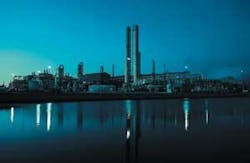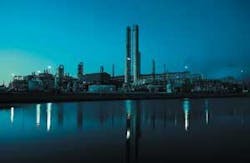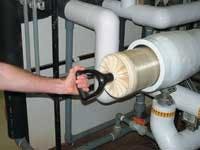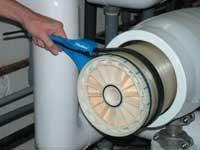New Coupling Technology Tackles Texan Leaks
Typically, in the reverse osmosis (RO) market, connections between system elements are made with the decades-old connection method of sliding couplers. These couplers increase energy costs by restricting flow, contain multiple sliding surfaces that abrade easily and result in costly leaks.
In light of these shortcomings, plants that employ RO technology are turning to new element coupling technology. This article discusses how a plant in Freeport, Texas, tested an alternative coupling option, resulting in reduced leaks and operating costs.
Coupling Alternatives
Sliding couplers are segments of pipe with radially compressed o-rings at both ends that are connected to the adjacent product water tubes. Although widely used, this coupling design contains drawbacks that can impair RO performance and add costs. O-rings are frequently pinched, rolled or twisted during installation, potentially causing leaks and product water contamination. The movement of couplers inside the product water tubes can also cause leaks.
In addition, traditional couplers require oil-based lubrication to run at optimum efficiency, a problem in plants producing ultrapure water that can easily be contaminated by coupling lubricants. Permeates can also be contaminated through worn and abraded sections of the couplers. Since the inside diameter of the coupler is smaller than that of the pipes it connects, traditional couplers increase flow resistance, energy consumption and costs.
Newer coupling options, such as iLEC interlocking endcaps from FilmTec Corp., a subsidiary of The Dow Chemical Company, eliminate the sliding surfaces and reduce the flow diameter within the coupling elements. This leads to a leak-free, maintenance-free operation and results in less labor and lower maintenance costs for the RO system and, consequently, the plant. In this case, reduced o-ring abrasion yields lower operating costs.
Leak-Free Option
Alternative element coupling technology has already helped reduce costs for USFilter, a Veolia Environment company that owns and operates a RO water treatment facility at Dow’s Texas Operations facility in Freeport. The plant purifies water from the nearby Brazos River for use by Dow as boiler feed water in its petrochemical operations that produce products such as polyethylene, ethylene glycol, polyurethanes, epoxy resins, caustic soda and vinyl chloride.
The constant demand for water means USFilter’s RO system is in continuous operation, idle only during flushing or element removal for off-site cleaning. The system experiences frequent biological and colloidal fouling due to high fouling feed water and, as a result, the elements are removed for off-site cleaning as many as four times per year. The constant removal and reinstallation of these elements severely tests both the seal and membrane integrity.
Cutting Costs
With traditional coupling systems in place, USFilter estimated the frequency of o-ring leaks at the plant was as high as one per train per month, with a typical frequency of eight leaks per month for the entire first-pass system. Each leak required a replacement of the damaged o-ring, which necessitated shutting down the train, opening the affected vessel, and removing and reinstalling the elements. These replacements cost the plant $4,800 annually, with a five-year net present value of $18,200. Additionally, the salt passage increase from leaking o-rings was sufficiently severe at times to require shutting down the entire train or even diverting the permeate.
In March 2002, the plant replaced coupling elements in a pressure vessel in the first stage of the first pass with FilmTec elements that employed the interlocking endcaps. Because each endcap was one single, axially compressed o-ring, there was no possibility of o-rings being pinched and damaged during removal and reinstallation. Despite high feed-side pressure drops, frequent starts and stops, and frequent handling, the elements have been operating for over two years with no o-ring leaks or other operational issues.
Conclusion
As this example shows, an effective way to improve water quality and lower operating costs in an RO plant is to invest in updated coupling technology to reduce energy-consuming flow resistance and o-ring leakage.
About the Authors: Dr. Jon Johnson is a Research Specialist with FilmTec Corp., a subsidiary of The Dow Chemical Company. His current projects include the design of membrane elements and their component parts, focusing on improved methods of sealing and the mechanical interactions between elements. A second area of research is the tradeoff between pressure drop and mass transfer in feed spacer materials. Johnson received a doctorate in mechanical engineering from the University of Minnesota. Steven Coker is a research specialist with FilmTec Corp.
For more information, contact 800-447-4369 or www.filmtec.com.



